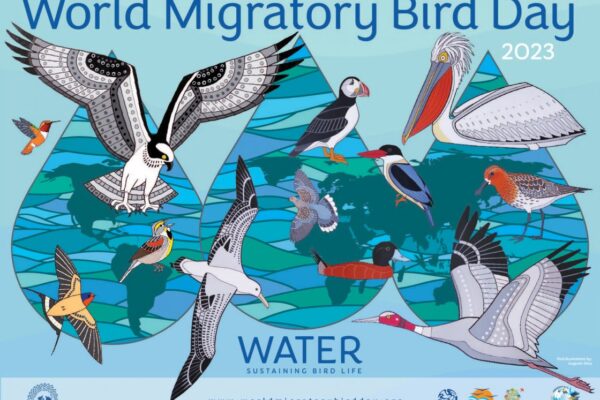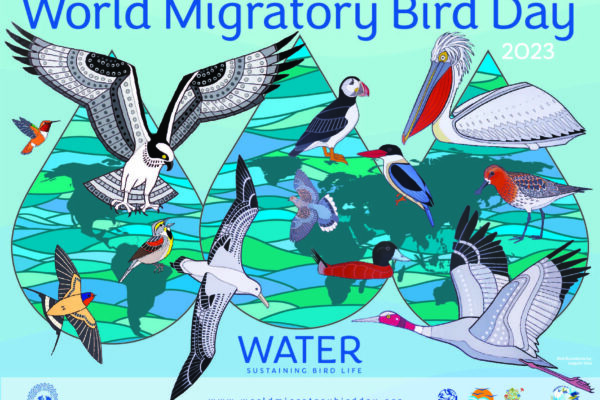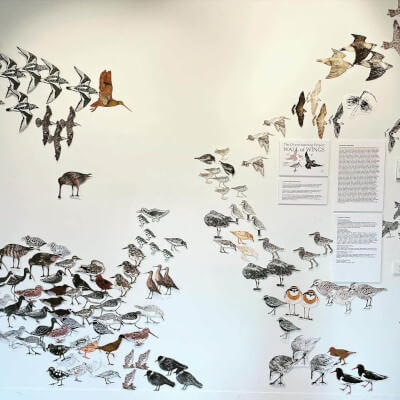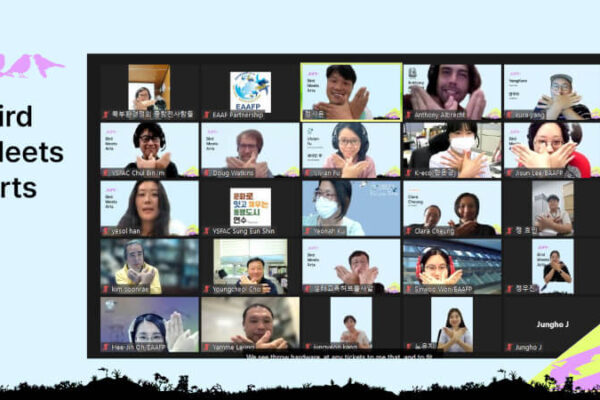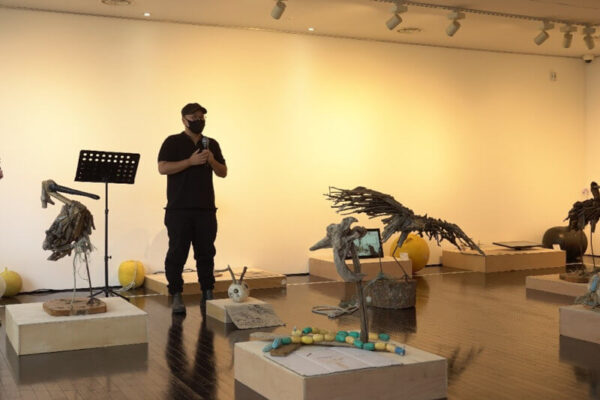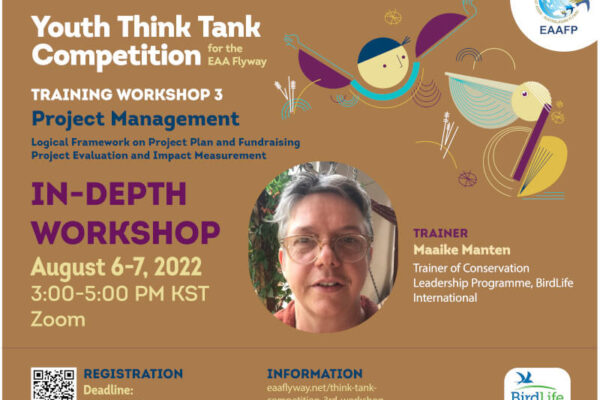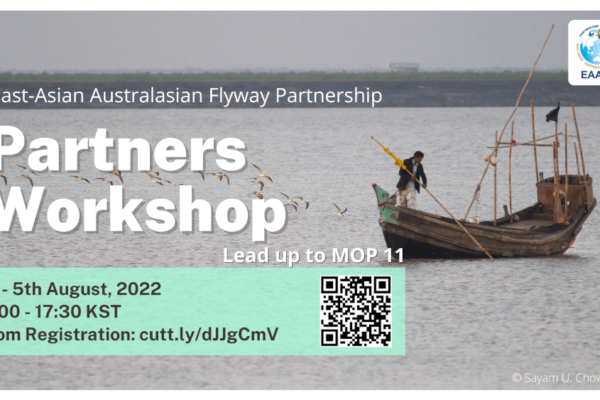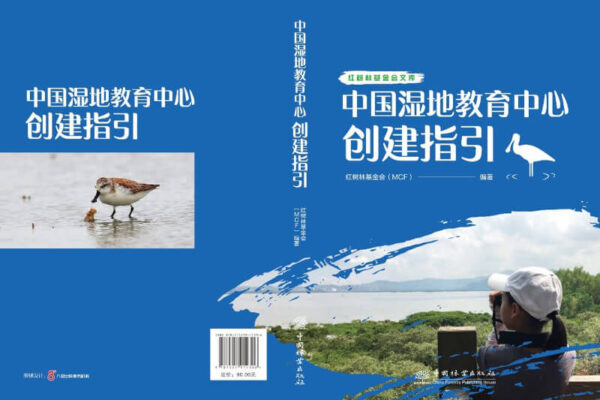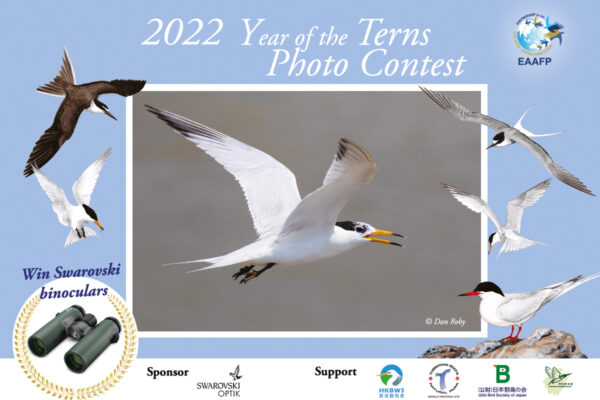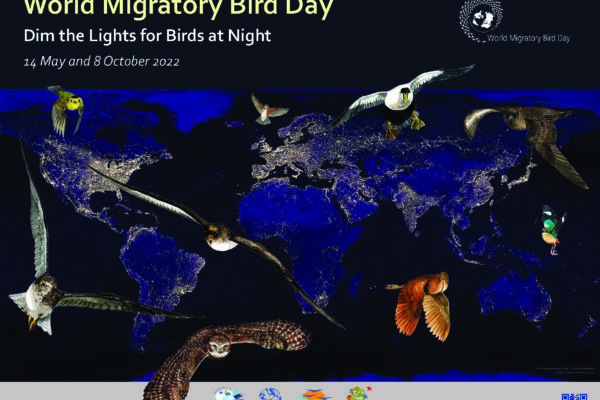-
World Migratory Bird Day 2023
What is World Migratory Bird Day? The World Migratory Bird Day (WMBD) is an annual global awareness-raising campaign to celebrate the amazing journeys of migratory birds, and to inspire worldwide conservation of migratory birds and their habitats. Traditionally observed on the second Saturday of May and October, the two days of World Migratory Bird Day are a way to reflect the cyclical nature of bird migration as well as the fact that there are varying peak migration periods in the northern and southern hemispheres. In 2023, WMBD will be celebrated on 13th May and 14th October. The campaign is a joint effort of the Convention on the Conservation of Migratory Species of Wild Animals (CMS), the African-Eurasian Migratory Waterbird Agreement (AEWA), Environment for the Americas and the EAAFP. On 17th March, the East Asian-Australasian Flyway Partnership (EAAFP) was announced as an official Partner of the World Migratory Bird Day campaign during the 11th Meeting of Partners (MOP11) of the EAAFP held in Brisbane, Australia (link). The new Partnership unites efforts to raise awareness to conserve migratory birds globally. Official website of World Migratory Bird Day: https://www.worldmigratorybirdday.org/ The Theme of World Migratory Bird Day 2023 The theme of World Migratory Bird Day 2023 is “Water: Sustaining Bird Life”. Water is fundamental to life on our planet. The vast majority of migratory birds rely on aquatic ecosystems during their life cycles. Inland and coastal wetlands, rivers, lakes, streams, marshes, and ponds are all vital for feeding, drinking, or nesting, and also as places to rest and refuel during their long journeys. On the other hand, aquatic ecosystems are becoming increasingly threatened around the world due to increasing human demand for water, integrating with problems of pollution and climate change. This imposes direct impacts on the availability of clean water and migratory birds that depend on them. This year’s World Migratory Bird Day campaign will highlight the importance of water for migratory birds and identify key actions for protecting water resources and aquatic ecosystems. Check the Campaign Strategy for promoting World Migratory Bird Day, click [here]. WMBD 2023 Press release, visit [here]. Learn about the EAA Flyway species featured on the 2023 WMBD poster Spoon-billed Sandpiper Scientific name: Calidris pygmaea Conservation status: IUCN - Critically Endangered, CMS - Appendix I Spoon-billed Sandpiper is the rarest shorebird and endemic to the East Asian - Australasian Flyway (EAAF). Listed as Critically Endangered on the IUCN Red List. It is a small shorebird with a peculiar spoon-shaped beak, thus nicknamed as “Spoony”. It breeds in the Arctic region in Russia Far East and winter at coasts in Southeast Asia. It is threatened by habitat loss and degradation, hunting and pollution at the wetlands. https://www.eaaflyway.net/spoon-billed-sandpiper/ Dalmatian Pelican Scientific name: Pelecanus crispus Conservation status: IUCN - Near Threatened, CMS - Appendix I The Dalmatian Pelican is a large waterbird and the biggest in the Pelican species. It has a big white body and a distinctive beak with an orange or yellowish gular pouch. The bird is a short-to-medium-distance migrant. Its distribution span across Central Eurasia to southern China coast. Hunting, habitat degradation due to wetland alteration and destruction are the main threat it is facing. Photo by Dean (Yu Deng, 邓郁) [copyright pending correction] https://www.eaaflyway.net/dalmatian-pelican/ Sarus Crane Scientific name: Grus antigone Conservation status: IUCN - Vulnerable, CMS - Appendix II Sarus Crane is a short-distance migrant with a bright red head and upper neck. They are inhabitants in wetlands and agriculture fields. There are populations rangingfrom India and Pakistan, Lower Mekong Basin including Myanmar, Vietnam, Cambodia Thailand, and a Australian population. They are vulnerable due to water diversions and unsustainable conversion of wetlands, habitat loss and other human disturbances. https://savingcranes.org/learn/species-field-guide/sarus-crane/ Join the WMBD Celebration Register your event on the Global Portal https://www.worldmigratorybirdday.org/register-your-event Resources for World Migratory Bird Day 2023 EAAFP World Migratory Bird Day 2023 Small Grant The Small Grant for 2023 World Migratory Bird Day (WMBD) has been established to provide financial support for EAAFP Partners and collaborators from EAAFP Task Forces and Working Groups, who plan on organizing public events and/or conservation action-oriented workshops at national or local levels for World Migratory Bird Day. We strongly encourage EAAFP Partners and collaborators to make an application for any suitable event or development of WMBD materials in local languages, that aims to raise awareness of the need of conserving migratory waterbirds and the value of their habitats in the East Asian – Australasian Flyway. For details, visit here. Deadline of applying for the WMBD October event: 31st August, 2023. World Migratory Bird Day 2023 Trello Board You can download everything from WMBD 2023 Trello Board [here]. World Migratory Bird Day 2023 Activities Come Fly With Me - 2023 World Migratory Bird Day Webinar with Sacha Dench Date/Time: 12 May, 2023 (Friday), 1500-1600 KST/0600-0700 GMT Meeting Platform: Zoom Language: English Registration: https://us02web.zoom.us/meeting/register/tZYocuChqjksGtQp0-YfuilaqDOKW06K5_GM More information, click [here]. You are invited to join the EAAFP Team on 13 May for the Global Big Day by eBird !! Be part of our Team to record migratory waterbirds in #EAAFlyway! Register an eBird account Go out and watch birds, keep count of the birds you see Submit your checklist to eBird and SHARE with "EAAFPTeam"! EAAFPTeam profile: https://ebird.org/profile/MzgyMzk1NA Benefit: Online version of "Birds of the World" will be FREE ACCESS starting 12th to 15th May!!! Materials for WMBD 2023 2022 WMBD Theme and Posters in EAAF Languages Languages Theme World Migratory Bird Day Poster links English Water: Sustaining Bird Life World Migratory Bird Day PDF Burmese ငှက်မျိုးစိတ်များ တည်တံ့ဖို့၊ ရေအရင်းအမြစ်များ ထိန်းသိမ်းစို့ ကမ္ဘာ့ရွှေ့ပြောင်းငှက်နေ့ PDF Bengali জলাশয় সংরক্ষণ নিরাপদ করে পাখির জীবন। বিশ্ব পরিযায়ী পাখি দিবস PDF Chinese (Simplified) 水:鸟类生命之所系 世界候鸟日 PDF Chinese (Traditional) 水:鳥類生命之所繫 世界候鳥日 PDF Filipino Tubig: Daluyang Búhay ng mga Ibon Pandaigdigang Araw ng mga Ibong Dayo PDF Indonesian Air: Menopang Kehidupan Burung Hari Migrasi Burung Sedunia PDF Japanese 鳥たちの命を支える水 世界渡り鳥の日 PDF Khmer ទឹកជួយទ្រទ្រង់ដល់និរន្តរភាពជីវិតសត្វស្លាប ទិវាសត្វស្លាបទេសន្តរប្រវេសន៍ពិភពលោក PDF Korean (DPRK) 세계철새의 날 Korean (RoK) 물: 새의 삶을 유지하다 세계 철새의 날 PDF Malaysian (Bahasa Malaysia) Air: Melestarikan Kehidupan Burung Hari Burung Hijrah Sedunia PDF Mongolian УС: Шувуудын Амьдралыг Тэтгэe Дэлхийн нүүдлийн шувуудын өдөр PDF Russian ВОДА: источник жизни птиц Всемирный день перелётных птиц PDF Thai วันนกอพยพโลก Vietnamese Nước: Duy trì sự sống của các loài chim Ngày chim di cư thế giới PDF Please contact us if you need raw design files to print or convert for your own local campaign. EAAFP Secretariat E-mail: wmbd@eaaflyway.net / communication@eaaflyway.net
Continue reading -
World Migratory Bird Day 2023 Global Campaign Poster Unveiled
We are pleased to present the 2023 World Migratory Bird Day global campaign poster. Featuring the work of Nicaraguan artist Augusto Silva, the poster shows twelve species that help tell the story of the importance of water to migratory birds. The selected bird species remind us that birds and many other species need wetlands for migration, wintering, and breeding. Some birds require specific types of water habitats, such as the tidal flats that Spoon-billed Sandpipers use during migration and winter, the mangrove forests and other coastal areas favored by Black-capped Kingfisher, open water for Dalmatian Pelican and Maccoa Duck to breed and the seasonally flooded fields in which the Sarus Crane uses. Water is essential for the survival of insects pursued by the Barn Swallow, the growth of nectar-producing plants frequented by the Rufous Hummingbird, and the health of grasslands inhabited by the Dickcissel and riverine forests used by the European Turtle Dove. The Atlantic Puffin and Wandering Albatross represent the oceans that make up 97% of all water on earth and are becoming increasingly polluted with chemicals and plastic waste. And finally, the Osprey serves as a conservation success story, reminding us that bird population declines can be reversed when we work together to conserve and protect our planet. The poster supports the theme of this year’s World Migratory Bird Day, which is “Water: Sustaining Bird Life,” a call of attention to the importance of water and its associated habitats to migratory birds. Unfortunately, increasing human demand for water, as well as human-driven pollution and climate change, threaten many of the water areas on which migratory birds depend. World Migratory Bird Day raises awareness of these issues and serves as a call to action for the protection of birds and their habitats. The two peak days of World Migratory Bird Day 2023 will be 13 May and 14 October, reflecting the cyclical nature of seasonal bird migrations. Events will take place all over the world in parks, nature centers, museums, libraries, schools, and other locations on those two peak days as well as throughout the year. To find an event near you, to register your own event, or to download this year’s campaign poster in multiple languages, go to worldmigratorybirdday.org. The EAAFP Secretariat is calling for support to translate the global poster to your own language, and to share the planned World Migratory Bird Day activities with us. If you require the design file of the poster, or are interested in supporting or involving in World Migratory Bird Day, please contact wmbd@eaaflyway.net.
Continue reading -
Celebration of World Migratory Bird Day 2022 in Australia: Stories of Home
In the 2022 WMBD October event, Australian Artist Kate Gorringe-Smith organised an interactive exhibition “Stories of Home” at the Joel Gallery, Louis Joel Arts and Community Centre. In the…
Continue reading -
EAAFP X YSFAC Bird Meets Arts Project International Workshop Successfully Concludes
Participants making bird-like hand…
Continue reading -
YSFAC X EAAFP
Programme Concluded With Art Exhibition On 2nd September, the <Bird Meets Arts> Closing Reception hosted by the EAAFP Foundation and (Yeonsu Foundation for Arts and Culture (YSFAC) took place in G Tower Gallery, Songdo,…
Continue reading -
Third Training Workshop of Youth Think Tank Competition for EAA Flyway is about Project Management
3rd Training Workshop of Youth Think Tank Competition for EAA Flyway Project Management Objectives Project Management skills are essential to the effectiveness and increase the impact of the conservation effort. To better equip young people, especially future conservation leaders, the East Asian – Australasian Flyway Partnership (EAAFP) organized a series of training workshops, with the 3rd workshop focusing on project management. The two-day workshop will cover principles of the logical framework of project plan and fund-raising, as well as project evaluation and impact measurement. The trainer will lead on exercises and the use of tools. Date: 6th – 7th August, 2022 (Saturday and Sunday) In-depth Workshop – Day 1 “Logical Framework on project plan and Fund-raising” Date and Time: 6th August, 2022, 15:00 – 17:00 KST (2 hours) Quota: 30 people Livestream on EAAFP Facebook: https://www.facebook.com/eaafp In-depth Workshop – Day 2 “Project Evaluation and Impact Measurement” Date and Time: 7th August, 2022, 15:00 – 17:00 KST (2 hours) Quota: 30 people Registration link: https://forms.gle/AJbpda5XL4389Ps29 Registration Deadline: 1st August 2022 Tool: Zoom Target Audience: Young conservationists, green groups for youth, local and international NGOs staffs, university students Eligibility for In-depth workshop: Aged 18-29 (under 30 on the date of application) Applicants with a nationality from EAA Flyway countries will be given priority to join Applicants to the EAAFP Youth Think Tank Competition will be given priority to join Important notice: We are using Zoom for the webinars and workshop. Please download the Zoom App (https://zoom.us/download) prior to the workshop. Successful applicants to the In-depth workshop will receive a separate email for the Zoom link and workshop rundown. It is a series of four workshops, only those who attend at least two In-depth workshops of the Youth Think Tank Competition Programme will receive a certificate of participation. Trainer Ms. Maaike Manten Trained as a political scientist in Amsterdam, the Netherlands, Maaike started working for BirdLife International in the year 2000. Since then she has worked for BirdLife in the UK, Kenya, Fiji and Rwanda, first as the institutional fundraiser for Africa and the Pacific, and later as the Regional Implementation Team (RIT) leader for the Critical Ecosystem Partnership Fund (CEPF)’s investment programmes in the Eastern Afromontane and the Mediterranean Basin biodiversity hotspots. Maaike has been working with CLP since 2009, providing project design, proposal writing and fundraising training to young conservationists in Africa, Asia, Latin America and the Middle East. She is also the co-author of the ‘Institutional Fundraising for Conservation projects’ manual that is available in 5 languages here. She is currently based in Kigali, Rwanda, and working as a freelance fundraiser and trainer. Click [here] to learn more about Maaike. Supporting Organizations Topics of Upcoming Workshops: More information about the Youth Think Tank Competition for the EAA: https://www.eaaflyway.net/thinktankcompetition/ 4th Workshop: Conservation Communication and Story Telling (early September 2022) Playback of the previous workshops, click [here]. ( https://www.youtube.com/playlist?list=PLVu-SI5onbMvPfamqQ5i84OpFx2CI6QaC)
Continue reading -
Announcement of EAAFP Partners Workshop leading up to MOP 11
In preparation of and to increase dialogue with and between Partners in the months leading up to MOP11, which will be held in Brisbane Australia, from 12th – 17th March 2023, the Secretariat is organizing a series of webinars endorsed by the EAAFP Management Committee with the following schedule and program. The webinar series will give Partners the opportunity to be briefed on important ongoing activities of the Secretariat and follow-up on Decisions made at MOP10. The EAAFP Secretariat is inviting all Partners to mark these dates and participate in the webinars. Title: EAAFP Partners Workshop lead up to MOP 11 Date/Time: 1 – 5 August 2022; 15:00 – 17:30 KST Organizers: EAAFP Secretariat and Management Committee Participants: EAAFP Partners, EAAFP Working Groups and Task Forces, Flyway Network Site Managers Language: English Meeting Platform: Zoom Register: https://cutt.ly/dJJgCmV *We invite everyone to join as many sessions as possible EAAFP Provisional Programme Day Programme Presenter/Moderator Day 1 Opening Remarks Robb Kaler, MC Chair Briefing on MOP11 Doug Watkins, Secretariat Chief Executive/Nick Davidson, TsC Chair Activities of the Management Committee Robb Kaler, MC Chair Report on the Secretariat’s workplan and budget Doug Watkins, Secretariat Chief Executive Day 2 Presentation on the Partner New Reporting Template for MOP11 Doug Watkins, Secretariat Chief Executive Interactive Session 1: How to increase the effectiveness of Working Group/Task Forces for EAAFP, following up on the Discussion Paper presented at MoP10 (link). (TBC) Day 3 MOP10 DD08: EAAFP Guidelines for National and Site Partnerships (link) Jennifer George, Consultant MOP10 DD 09: EAAFP Guidelines for the Sister Site Program (link) Day 4 Presentation on the revised CEPA Action Plan 2023 – 2028 Casey Burns, CEPA Working Group Chair Update on the ADB Regional Flyway Initiative Duncan Lang, Asian Development Bank /Doug Watkins, Secretariat Chief Executive /Ding Li, BirdLife International Day 5 Conservation Status Review of Migratory Waterbird Populations for the EAAFP [MOP10 DD 12] / Q&A Taej Mundkur, Consultant to Wetlands International Interactive Session 2: How to expand, strengthen and engage the Flyway Site Network, including adopting a more simplified and focused nomination form (SIS) Nick Davidson, TsC Chair/Qing Zeng, Science Officer Closing Remarks Robb Kaler, MC Chair For inquiries, please email to secretariat@eaaflyway.net.
Continue reading -
New Publication “ China Wetland Centers Manual for Planning and Practice” by Mangrove Foundation
By 2021, China has 64 wetlands of International Importance, 20 Flyway Network Sites, 602 Wetland Nature Reserves, 899…
Continue reading -
Join 2022 “Year of the Terns” Photo Contest
English Simplified Chinese Traditional Chinese Japanese Korean Indonesian Official Photo Contest website: https://woobox.com/dsmyac Photo Contest Guidelines PDF: English / Bahasa Indonesia / Chinese [Simplified / Traditional] / Japanese/ Korean For more in Japanese, visit the Wild Bird Society of Japan (WBSJ) website: https://www.wbsj.org/activity/event/terns-photocontest-2022/ Learn more about the "Year of the Terns" campaign, click here. EAAFP Year of The Terns Photo Contest There are over 150 seabird species in the East Asian – Australasian Flyway. They are facing the risk of extinction due to various threats such as incidental bycatch, overfishing, pollution, invasive species, and habitat loss. To raise awareness of seabirds and their conservation, the East Asian – Australasian Flyway Partnership (EAAFP) and the Seabird Working Group designated 2022 as the “Year of the Terns”. Birdwatchers and photographers are encouraged to join the “Year of the Terns” Photo Contest to discover the beauty of the seabirds, especially terns, and win exciting prizes! Eligibility The Year of the Terns Photo Contest is open to all participants regardless of age, gender, residence and nationality. Participation in the Year of the Terns Photo Contest is free - there is no registration fee. All entries must involve images photographed in countries within the East Asian-Australasian Flyway Partnership’s region. Submission Guidelines 1. Submission deadline: 17 September (Saturday), 11:59 p.m. (KST). 2. All entries must be uploaded to the Year of the Terns Photo Contest webpage. 3. Photos must be taken from 1 January 2022 through 17 September 2022. 4. There are two categories for entrants to submit entries and each entrant may submit up to 3 photos for the whole contest. 5. All submitted photographs must be in JPEG format, and NOT exceed 5MB in file size. Rename the file name to Photographer's name_MMDD (date of entry), e.g. Kenneth_Lam_0706. 6. Photographs should not be substantially altered with digital means beyond the standard types of edits. 7. No signature, logos, and watermark text should be present on submitted images. How to win: (Please refer to the Contest guidelines for further details.) 1. The Best Photo of Tern Species Each entrant may only submit one entry per species. Entrants may, however, submit multiple entries covering different species of terns. Each entrant needs to write the description of the photo in English within 100 words (e.g., threats to the species, conservation efforts). 2. Tern Photo with the Best Conservation Message Each entrant may submit a tern photo and message in English within 200 words. Each photo and its corresponding message should highlight, for example, the threats to seabirds and the marine environment, conservation efforts, or relations between or among seabirds and other creatures in marine ecosystems. Most Voted Photo The entrant whose photo receives the most votes on the Year of the Terns Photo Contest webpage will be the winner. Note: Entrant who submitted all 3 photos to category 1 will not be able to submit additional photos for category 2. Likes’ on social media are not regarded as valid votes. Only votes on the webpage will be counted. Inquiries: Please contact us at yearoftheterns@gmail.com Please use the hashtag-YearofTerns (#YearofTerns) for promoting the event or calling for votes on the Year of the Terns Photo Contest webpage. Winners Announcement [The Best Photo of Tern Species] Photographer: Haocheng Wang Species: Chinese Crested Tern Date of photo taken: 18 August 2022 Location: Jiaozhou Bay, Qingdao, China [Tern Photo With the Best Conservation Message] Photographer: Erickson A. Tabayag Species: Sooty Tern Date of photo taken: 29 July 2022 Location: Lawak Island, Municipality of Kalayaan, Palawan, The Philippines [Most Voted Photo] Photographer: Le Manh Hung Species: Bridled Tern Date of photo taken: 18 May 2022 Location: Vietnam Photo Contest Judges Meet the "Year of the Terns" Photo Contest Judging Panel: Prof. Daniel Roby Dedicated to Seabird research and conservation for over 25 years, Professor Daniel Roby was enthralled by wildlife from a very young age. Dan has had an illustrious career as an educator and conservationist, recently receiving the Lifetime Achievement Award of the Pacific Seabird Group. He has also been involved in countless projects ranging from studying the long-term effects of the Exxon Valdez oil spill on seabirds in Alaska to becoming the technical advisor for the restoration of the Critically Endangered Chinese Crested Tern in China. Currently retired, Dan is working on editing a book on the conservation and restoration of Oregon’s birds. Ms. Angelique Songco Starting her career in the Armed Forces of the Philippines, later becoming a diving instructor after falling in love with the ocean, Angelique Songco has more than 20 years of experience as a site manager of Tubbataha Reefs Natural Park, an UNESCO World Heritage Site and Flyway Network Site. Referred to as “Mama Ranger,” Angelique is also a member of the EAAFP Seabird Working group and works on the frontier in safeguarding important sites. With Angelique at the helm, Tubbataha received the Platinum Global Ocean Refuge Award – acknowledged as a model site and one of the best-managed marine protected areas in the world. Dr. Kiyoaki Ozaki Dr. Ozaki has fifty years of experience as a wildlife biologist and conservationist working in Japan and Southeast Asian countries, with special interests in Okinawa Rail, Short-tailed Albatross, Japanese Crested Ibis, Roseate and Black-naped Terns. His studies include ecology, migration and conservation biology. He was also responsible for running the bird banding program in Japan between 1995-2017. Dr. Ozaki is the Deputy Director-General of Yamashina Institute for Ornithology since 2010, as the President of the Japanese Bird Banding Association since 2022, and as the President of Ornithological Society of Japan from 2018-2021. Ms. Edin Whitehead As a seabird scientist and conservation photographer in Aotearoa, New Zealand, Edin “combines science and storytelling to help people explore our natural world.” She works for the Northern New Zealand Seabird Trust as a biologist and photographer. She additionally spends her ‘free’ time in the wilderness, on conservation projects as a volunteer, or out at sea, to inspire people to explore, understand and conserve our earth. Edin is a doctoral researcher at the University of Auckland. She also teaches photography workshops or guides pelagic trips to take people to see seabirds that live in the Aotearoa area. Mr. Yat-tung Yu Yat-tung Yu, a veteran birdwatcher, has always been fascinated by seabirds, particularly terns. He initiated the breeding tern survey in Hong Kong in 1998 and continues to conduct and promote tern ringing locally in Hong Kong and in the EAA Flyway. Despite his efforts, however, terns unfortunately still receive little attention from people in the region. Regardless, he aims to further promote tern research and conservation activities to save them from various threats. Currently, Yat-tung is the Director of the Hong Kong Bird Watching Society and Coordinator of the EAAFP Seabird Working Group.
Continue reading -
World Migratory Bird Day 2022 calls for reducing Light Pollution for migratory birds
“Light Pollution” is this year’s theme of World Migratory Bird Day, an UN-backed celebrated awareness-raising campaign aiming to inspire the worldwide conservation of both migratory birds and their habitats. With the official slogan “Dim the Lights for Birds at Night!”, this global campaign focus on the impacts of light pollution on migratory birds. Our Earth continues to become brighter by 2% each year, light pollution has become an increasing problem for nature. A study told us that nowadays, more than 80% of the world's population lives under a “lit sky”. Humans are negatively affected by light pollution, with increasing risks of sleep disorders, diabetes, depression and other health problems. Light Pollution is also significantly impacting wildlife and ecosystems Every year, light pollution contributes to the death of millions of birds, especially the nocturnal migrant. It also interferes with birds’ internal clocks, vocal communication, foraging behaviors and disrupts migrations. Many studies showed that artificial lights at night (ALAN) attract and disorient birds flying at night, causing them to circle in illuminated areas, depleting their energy reserves and putting them at risk of exhaustion, predation and lethal collision. Seabirds are vulnerable to artificial Light at night, in East Asian-Australasian Flyway, a 15-year study showed light pollution caused the mortality of 39% of Short-tailed Shearwater fledglings on Phillip Island, Australia. The effects of light pollution on migratory birds unfortunately have not been extensively studied and discussed in the East Asian-Australasian Flyway, yet the campaign this year shed light to generate awareness from the public as well as encourage studies and concrete actions from key stakeholders to address it. Solutions are Readily Available People started to realize the problem and solutions to address the impacts of light pollution are readily available. For example, the Australian Government (EAAFP Partner) proposed Resolution 13.5 “Light Pollution Guidelines for Wildlife” which was adopted during the 13th Conference of the Parties to CMS in 2020. Numerous governments, cities, companies, and communities around the world are already taking steps to address light pollution. New guidelines focusing on migratory landbirds and bats are currently being developed under CMS. They will be presented to CMS Parties for adoption at the 14th Meeting of the Conference of the Parties to CMS in 2023. Natural darkness has conservation value in the same way as clean water, air, and soil, and should be protected. World Migratory Bird Day 2022 – Animated Promo Video About World Migratory Bird Day Launched in 2006, WMBD was established and initiated by the Secretariat of the Agreement on the Conservation of African-Eurasian Migratory Waterbirds (UNEP-AEWA) in collaboration with the Secretariat of the Convention on the Conservation of Migratory Species of Wild Animals (CMS), and partnered with Environment for the Americas (EFTA) since 2017. WMBD is now celebrated twice every year, on the 2nd Saturday in May and October. People around the world take action and organize public events such as bird festivals, educational and promotional programmes and birdwatching excursions to celebrate WMBD. Official website: https://www.worldmigratorybirdday.org/ Read also: The Australian Government: National Light Pollution Guidelines for Wildlife Including Marine Turtles, Seabirds and Migratory Shorebirds, and a series of promotional materials, click hereto find out more. Global Press release on WMBD: https://www.worldmigratorybirdday.org/news/2022/press-release-world-migratory-bird-day-light-pollution-threatens-birds-across-world Resources: 2022 WMBD 2022 Campaign Strategy: https://www.cms.int/sites/default/files/publication/wmbd_2022_campaign_strategy_light_pollution.pdf WMBD global social media package: https://trello.com/b/GCeoS3bc/world-migratory-bird-day-2022-global-social-media-pack EAAFP 2022 WMBD website, posters and resources: https://www.eaaflyway.net/world-migratory-bird-day-2022/ EAAFP 2022 WMBD Factsheet
Continue reading

